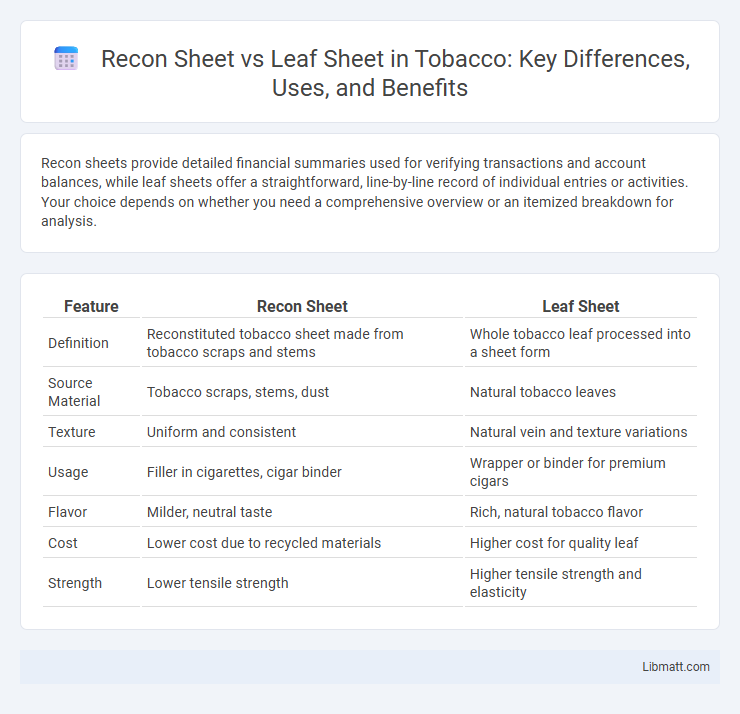Recon sheets provide detailed financial summaries used for verifying transactions and account balances, while leaf sheets offer a straightforward, line-by-line record of individual entries or activities. Your choice depends on whether you need a comprehensive overview or an itemized breakdown for analysis.
Table of Comparison
| Feature | Recon Sheet | Leaf Sheet |
|---|---|---|
| Definition | Reconstituted tobacco sheet made from tobacco scraps and stems | Whole tobacco leaf processed into a sheet form |
| Source Material | Tobacco scraps, stems, dust | Natural tobacco leaves |
| Texture | Uniform and consistent | Natural vein and texture variations |
| Usage | Filler in cigarettes, cigar binder | Wrapper or binder for premium cigars |
| Flavor | Milder, neutral taste | Rich, natural tobacco flavor |
| Cost | Lower cost due to recycled materials | Higher cost for quality leaf |
| Strength | Lower tensile strength | Higher tensile strength and elasticity |
Introduction to Recon Sheets and Leaf Sheets
Recon sheets and leaf sheets serve distinct functions in accounting and bookkeeping processes. Recon sheets provide detailed reconciliations of accounts to verify accuracy between different financial records, while leaf sheets document individual transactions or entries for specific accounts. Your understanding of these tools enhances financial accuracy and streamlines auditing tasks.
Key Differences Between Recon Sheets and Leaf Sheets
Recon sheets provide a detailed summary of financial transactions and account reconciliations, enabling the identification of discrepancies between recorded and actual balances. Leaf sheets function as individual ledger pages that document specific transactions related to a single account, offering granular tracking of debits and credits over a period. The primary difference lies in recon sheets focusing on the aggregation and validation of multiple accounts for accuracy, whereas leaf sheets concentrate on detailed, transaction-level recording within individual accounts.
Purpose and Applications of Recon Sheets
Recon sheets serve as critical financial documents used to reconcile discrepancies between different accounting records, ensuring accuracy and completeness in transaction tracking. They are primarily applied in auditing, accounts payable, and inventory management to verify balances and identify errors or unauthorized entries. Your business benefits from using recon sheets by maintaining transparent and reliable financial reporting, crucial for compliance and informed decision-making.
Purpose and Applications of Leaf Sheets
Leaf sheets serve as detailed supporting documents in accounting, used to summarize and explain specific transactions linked to a general ledger account, ensuring accuracy and transparency in financial records. Their primary purpose is to provide clarity and verification for auditors and internal reviewers, facilitating easier tracing of financial activities and adjustments. You can apply leaf sheets in bank reconciliations, inventory tracking, and expense documentation to maintain organized and verifiable accounts.
Data Organization: Recon Sheet vs Leaf Sheet
Recon sheets consolidate transactional data to provide a comprehensive overview for verification and discrepancy resolution, while leaf sheets organize individual entries by category or date for detailed analysis. Your data organization becomes more efficient with recon sheets through summary-level insights, whereas leaf sheets facilitate granular tracking and auditing of specific records. Choosing between them depends on whether you need broad reconciliation or in-depth examination of discrete data points.
Benefits of Using Recon Sheets
Recon sheets streamline financial reconciliation by providing a clear, itemized comparison of transactions, reducing errors and discrepancies. They enhance accuracy in accounting processes by aligning data from various sources, which accelerates audit readiness and improves cash flow management. Implementing recon sheets supports regulatory compliance and strengthens internal controls within financial operations.
Advantages of Leaf Sheets
Leaf sheets offer distinct advantages in inventory management by providing a detailed breakdown of individual items, facilitating precise tracking and verification. These sheets enhance accuracy in serial number documentation, reducing discrepancies during audits or reconciliations. Their granular format supports real-time updates and seamless integration with inventory software, optimizing operational efficiency.
Common Use Cases in Various Industries
Recon sheets commonly serve in finance and accounting for transaction verification and discrepancy resolution, ensuring accurate ledger reconciliation. Leaf sheets are often utilized in manufacturing and quality control sectors to document detailed inspection results and maintain audit trails. Your choice depends on industry-specific needs for data validation and record-keeping precision.
Limitations and Challenges: Recon Sheet vs Leaf Sheet
Recon sheets face limitations in accurately capturing complex financial transactions due to reliance on manual data entry, increasing the risk of errors and inconsistencies. Leaf sheets, while offering more granular data tracking, often suffer from scalability challenges and higher processing times when reconciling large volumes of records. Your choice between recon sheets and leaf sheets should consider these constraints to optimize accuracy and efficiency in financial reconciliation.
Choosing the Right Sheet for Your Needs
Choosing between a recon sheet and a leaf sheet depends on the intended application, with recon sheets offering durability and thicker material ideal for heavy-duty projects or repairs. Leaf sheets, characterized by their thin, delicate layers, are perfect for decorative finishes, gilding, and intricate artwork requiring a subtle metallic sheen. Evaluating factors such as material strength, flexibility, and visual effect ensures selecting the right sheet aligns with both functional and aesthetic requirements.
recon sheet vs leaf sheet Infographic

 libmatt.com
libmatt.com